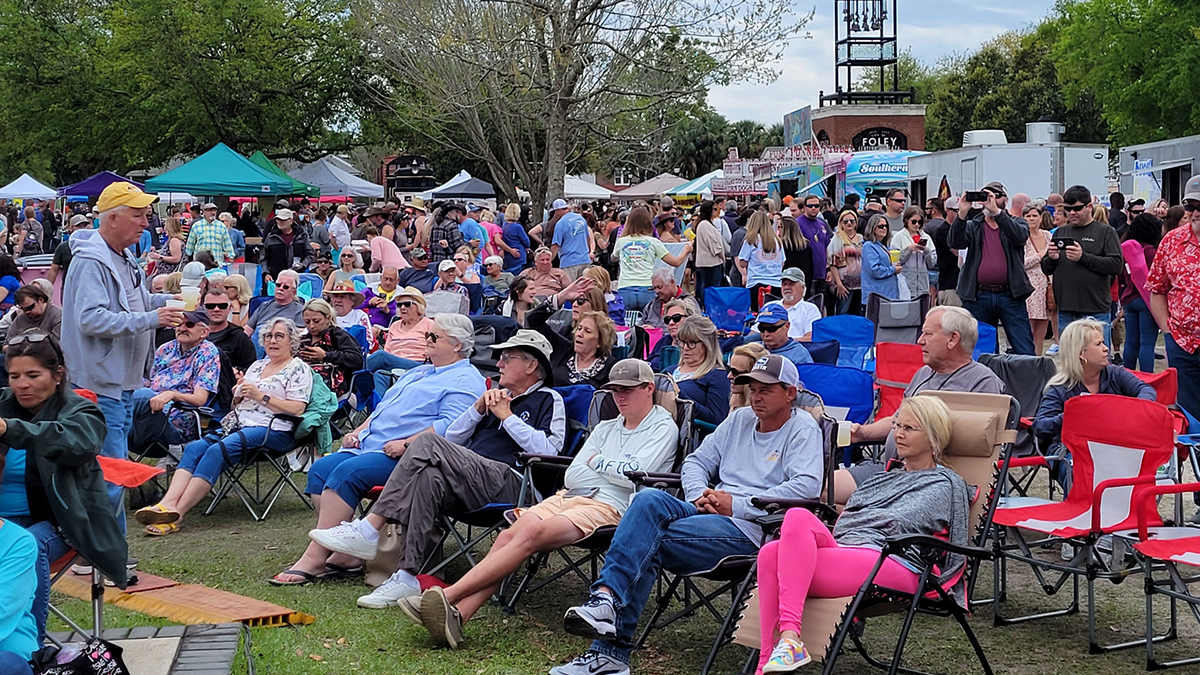Muscle Shoals National Heritage Area filled with natural, cultural resources

Wheeler National Wildlife Refuge. (Erin Harney)
The National Park Service (NPS) turned 100 years old this year. Over the past century, the organization has grown from 35 national parks to more than 400 sites under the protection of the NPS today. From national seashores, monuments, heritage and historic sites, trails and military parks, the variety is as vast as the history they contain. There are nine National Park Service sites in Alabama that drew 790,000 visitors with a $31 million economic impact last year. Alabama NewsCenter is spending the rest of this centennial year highlighting each Alabama site.
https://youtu.be/0ykvO8UN3g0
Muscle Shoals National Heritage Area

Alabama Music Hall of Fame, 2010. (Carol Highsmith, Library of Congress)
In 1999, the Muscle Shoals community held two meetings to discuss the wealth of natural and cultural resources in the area, and how they could be leveraged to improve the quality of life for area residents. Following the meetings and a year of research and inquiry, U.S. Rep. Bud Cramer of Alabama “introduced legislation into the House of Representatives, in 2001, directing the Secretary of the Interior to study the suitability and feasibility of establishing the area as a national heritage area,” the NPS said.
According to the NPS, an area must have significant historical, cultural or natural features that “help tell a national story of the country’s evolution” to be considered as a national heritage area, and Congress must approve the designation. The legislation submitted by Cramer was signed into law in 2002, and the designation was approved in 2009.
The Muscle Shoals National Heritage Area (MSNHA) preserves the “history of the region by focusing on three main themes: music, Native American Heritage and the Tennessee River,” the University of North Alabama (UNA) said. Today, UNA hosts the MSNHA, with offices in Florence.
Visiting the Muscle Shoals National Heritage Area
The MSHNA spans six counties in northern Alabama, with over 90 natural and cultural sites. The MSHNA website provides a helpful search tool to view the different sites by type of attraction or activity. There are 10 categories included in the heritage area: Native American, African-American, Natchez Trace, Civil War, Tennessee River, architectural, cultural, music, natural and transportation.
The main MSNHA office on the UNA campus is: Muscle Shoals National Heritage Area, UNA Box 5231, Florence, AL 35632. For general information or assistance planning a visit to one of the MSNHA sites, call 256-765-5028.
The Native American sites include Indian mounds dating to the Woodland period (1000 B.C. to A.D. 1000) at the Florence Indian Mound and Museum and Oakville Indian Mound and Museum; the Natchez Trace Parkway, which served as a travel and trade route for Native Americans and early traders; and sites that memorialize the removal of Indians from the Southeast, including the Black Warrior’s Path/Mitchell Trace, The Trail of Tears, The Wichahpi Commemorative Stone Wall, Tuscumbia Landing and Waterloo.
The African-American sites include two music-related sites – the Alabama Music Hall of Fame and W.C. Handy’s Home, Museum and Library – that commemorate the rich rhythm and blues traditions that developed in the South. The Jesse Owens Museum shares the story of Jesse Owens. Owens was born in 1913 to a sharecropper, but went on to become an Olympian, national hero and world-recognized humanitarian. In addition, the Fort Henderson Historic Sites and Trinity High School, in Limestone County, recognize the race relation challenges that persisted from the Civil War through the 20th century.
The Civil War sites in the heritage area include miles of trails, some made for driving, others for hiking, biking or horseback riding, that take visitors past historic sites and battlefields. Those include the Tennessee Valley Civil War Trail- Alabama Civil War Trail, the Richard Martin Trail (Rails to Trails) and Athens-Limestone County Civil War Trail. There are several historic homes and property sites that date to the Civil War, including the Donnell House, Edith Newman Culver Memorial Museum, Fort Henderson Historic Site and Pond Spring: Home of General Joseph Wheeler. The Blue and Gray Museum of North Alabama contains one of the largest private collections of Civil War artifacts in the state. The Old State Bank in Decatur and Pope’s Tavern in Florence both served as hospitals during the Civil War. In addition, the General Andrew Jackson Black Walnut Tree is designated as “A Living Witness to the Signing of the U.S. Constitution.”
The Tennessee River boasts a number of opportunities to enjoy life on the water, including the family-friendly Doublehead Resort, Riverfront Park and Point Mallard Park. Top fishing spots include Ingalls Harbor, McFarland Park, Pickwick, Wilson and Wheeler lakes. The Wheeler National Wildlife Refuge, Givens Interpretive Center, Tennessee Valley Authority Reservation and Joe Wheeler State Park provide opportunities to view and learn about nature and wildlife in the area. For those interested in the history of the Tennessee Valley area, the exhibition Pathway: Walk through the History of Muscle Shoals, in the Muscle Shoals City Hall, documents the town’s history.

Pond Spring: Home of General Joseph Wheeler, Jan. 21, 1931. (Library of Congress)
The MSNHA contains over 30 homes, buildings, trails or districts that have architectural significance. From the Forks of Cypress Plantation, the first home in America with a peristyle colonnade (columns at all four sides) to Frank Lloyd Wright’s Rosenbaum House built in 1940, the history and architectural significance of the area is remarkable. There are multiple historic districts in Decatur, Athens, Florence, Hartselle, Courtland, Russellville, Sheffield and Tuscumbia. The heritage site includes three driving trails, the Amen, Hallelujah and Limestone County Antebellum Trails, and the Florence-Lauderdale, Tuscumbia, and a Step Back in Time Historic District of Athens Walking Tours. Additional sites include the Colbert County Courthouse, Coldwater Stagecoach Stop, Courtland Heritage Museum, the Town of Mooresville, Belle Mont Mansion, College Inn-Newby Golf Station, Glory Road in Limestone County, Historic Bank Street and Old State Bank in Decatur, Historic LaGrange College Site Park and Pioneer Settlement, Houston Memorial Library and Museum, Nitrate Village One, Pine Torch Baptist Church, Pond Spring: Home of General Joseph Wheeler, Princess Theatre for the Performing Arts, Rock of Ages Tour, and The Altar of the New Testament & Founders Hall.
The heritage area’s cultural sites include a number of museums. Among them are the Children’s Museum of the Shoals, Cook’s Natural Science Museum, Red Bay Museum, the Tennessee Valley Museum of Art, the University of North Alabama Art Gallery, the Hartselle and Carnegie Visual Arts Centers, and the Kennedy-Douglass Center for the Arts. The cultural category includes several sites that are also listed within other categories of the national heritage area. Additional sites specifically preserved for their cultural significance include the Coon Dog Memorial Graveyard, Ivy Green: Birthplace of Helen Keller, the Morgan County Archives, and the Ritz and Shoals theatres.
Courtesy of the 2013 documentary, Muscle Shoals, the area is well-known for its long and successful music recording history at the FAME Recording and Muscle Shoals Sound Studios. The musical history of the area is documented and preserved at the Alabama Music Hall of Fame, the Red Bay Museum, W.C. Handy Museum and Library, and in the exhibition, Pathways: Walk through the History of Muscle Shoals at the Muscle Shoals city hall.

Tuscumbia Railroad Historic Depot. (Erin Harney/Alabama NewsCenter)
The category of natural sites shares many parks and lakes included in the Tennessee River category. Unique to this category are the Cane Creek Canyon and Shoals Creek Preserves, Bear Creek Lakes, Delano, Wildwood, and Spring Parks, Dismal Canyon Conservatory, Limestone County Canoe and Kayak Trail, and the William Bankhead National Forest. The Bankhead National Forest covers over 180,000 acres and offers visitors the opportunity to hike, camp, swim, or horseback ride. The heritage area also contains 19 of the 50 bird watching sites that make up the North Alabama Birding Trail.
The MSNHA preserves two transportation-specific sites, the Old Railroad Bridge in Sheffield, and the Tuscumbia Railroad Historic Depot. The Old Railroad Bridge was built in 1839 and served as a transportation route across the Tennessee River for many years. Now, it is a pedestrian-only bridge with views of Pickwick Lake. The Tuscumbia Railroad Depot was built in 1888 and contains a museum with memorabilia and train simulators.



























